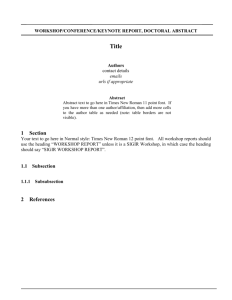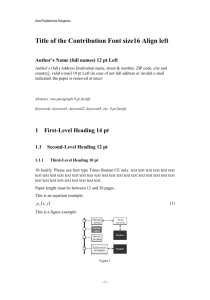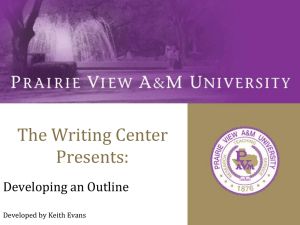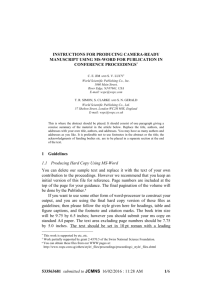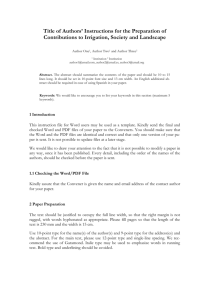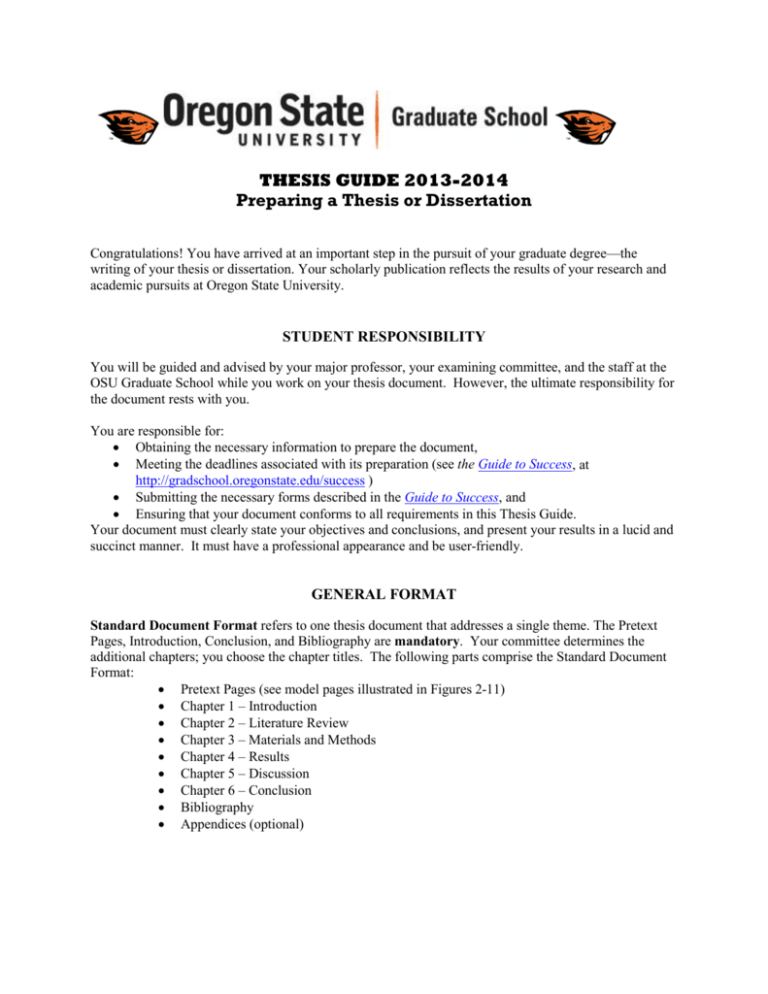
THESIS GUIDE 2013-2014
Preparing a Thesis or Dissertation
Congratulations! You have arrived at an important step in the pursuit of your graduate degree—the
writing of your thesis or dissertation. Your scholarly publication reflects the results of your research and
academic pursuits at Oregon State University.
STUDENT RESPONSIBILITY
You will be guided and advised by your major professor, your examining committee, and the staff at the
OSU Graduate School while you work on your thesis document. However, the ultimate responsibility for
the document rests with you.
You are responsible for:
• Obtaining the necessary information to prepare the document,
• Meeting the deadlines associated with its preparation (see the Guide to Success, at
http://gradschool.oregonstate.edu/success )
• Submitting the necessary forms described in the Guide to Success, and
• Ensuring that your document conforms to all requirements in this Thesis Guide.
Your document must clearly state your objectives and conclusions, and present your results in a lucid and
succinct manner. It must have a professional appearance and be user-friendly.
GENERAL FORMAT
Standard Document Format refers to one thesis document that addresses a single theme. The Pretext
Pages, Introduction, Conclusion, and Bibliography are mandatory. Your committee determines the
additional chapters; you choose the chapter titles. The following parts comprise the Standard Document
Format:
• Pretext Pages (see model pages illustrated in Figures 2-11)
• Chapter 1 – Introduction
• Chapter 2 – Literature Review
• Chapter 3 – Materials and Methods
• Chapter 4 – Results
• Chapter 5 – Discussion
• Chapter 6 – Conclusion
• Bibliography
• Appendices (optional)
2
Manuscript Document Format is a single thesis document made up of several scholarly manuscripts or
journal articles addressing a common theme. All manuscripts/articles must be related or address a single,
common theme. You must be the primary author of each manuscript. Co-authors other than your major
professor must be mentioned in a Contribution of Authors page (see Figure 9, page 8) in the pretext
section of the document. Formatting should be consistent for each journal article and must follow the
thesis guide formatting not the separate journal formats. The following parts comprise the Manuscript
Document Format:
•
•
•
•
•
•
•
Pretext Pages (see model pages illustrated in Figures 2-11)
Chapter 1 – General Introduction (common introduction linking all manuscripts
thematically)
Chapter 2 – First Manuscript
Chapter 3 – Second Manuscript
Chapter 4 – General Conclusion (common conclusion linking all manuscripts
thematically)
Bibliography (common bibliography covering all manuscripts, although each manuscript
may have its own reference section)
Appendices – (optional)
Note: Within the larger Manuscript Format thesis document, Chapter Heading Pages (see Figure 1
below) precede individual manuscripts that have already been published. If not published, page is not
required. Manuscripts must uniformly conform to these thesis guidelines.
Page #
MANUSCRIPT TITLE
CENTERED HERE
Your name and other authors
Journal
Address of Journal
Issue manuscript appears in
Figure 1. Chapter Heading Page
for Manuscript Document Format
3
PAGE LAYOUT AND TEXT REQUIREMENTS
Margin Requirements:
The left margin must be at least 1 inch unless printing and binding a personal or departmental copy then
change to 1.5 inch. All other margins must be at least 1 inch, preferably 1.2 for top margin. Nothing may
invade a margin. Every page must meet margin requirements. Margin requirements are especially
important if binding a copy of your thesis.
Page Numbering:
Pretext pages: Do not number pretext pages.
Body: The body of the text begins with page 1 and all successive pages are numbered consecutively with
Arabic Numbers (e.g. 2, 3, etc.) including Appendix/Appendices and Bibliography. Page numbers
should be the same size and font as the body of the text
Page numbers must appear at the top right corner of pages, approximately 1inch from the top edge of the
page and at least 1 inch from the right edge of the page. Page numbers must not invade any margins.
There should be at least one return between the page number and the first line of text.
Title:
Your title must be worded exactly the same throughout the document as it appears on the Abstract page,
Title page and centered on page one (optional). Titles longer than one line should be single-spaced. The
document's title does not count as a heading level.
Text Spacing:
Use either double or 1.5 line spacing for the body of text. Do not mix the spacing. Use single spacing in
the following situations:
• For headings longer than one line
• For figure/table titles/legends
• For bibliographical and reference citations
• For direct quoted material
• For items listed within the body of the text (optional)
• Where indicated in the pretext section
4
TEXT FORMAT REQUIREMENTS
Font: Use regular, unadorned print, 10- to12-point size for text (headings may be 14-point only if all
headings are 14-point). Font size within figures & tables can be smaller but must be readable. Use the
same font style and font size throughout.
Headings: Chapter names are Level 1 headings. Subheadings of a chapter are Level 2 headings.
Subheadings of chapter subheadings are Level 3 headings, and so forth. Each level must look different
from the other levels. Headings of the same level must look the same throughout the document. All
headings, regardless of level, must be the same font size. Either number all headings or number none
(See figures 10a and 10b). Single space headings that are more than one line. Use adequate and consistent
spacing between the headings and the text. A minimum of two subheadings may be used within a given
level. Each level 1 heading begins a new page.
Appendix Heading Page: A numbered, counted page should be inserted in front of your document's
appendix/appendices. The word APPENDIX (or APPENDICES) should be centered about 1/3 down this
page. This heading page and its page number should appear in the Table of Contents.
Blocked Quotes: Use Blocked Quotes for quoted material longer than three lines. Use the same font size
as within the text. Single-space the quotation, and indent it evenly on both sides. There is no need to
justify quotations.
References: Use the same font size as within the text. Choose a reference style with the guidance of your
major professor and your committee and be consistent. Single-space each citation, and use adequate and
consistent spacing between citations.
Endnotes: Footnotes collected at the end of a chapter are called endnotes. Use the same font size as
within the text. Single-space each endnote, and use adequate and consistent spacing between endnotes.
Orphan Lines/Headers/Footnotes: No orphan lines may appear at the top or bottom of a page. No
headers or footers may be used. Footnotes are acceptable.
FIGURES/TABLES
Figures/Tables may be located in one of two places in your document. You must choose one system and
use it consistently throughout your work.
1. Insert the figure within the text, as close as possible after the first reference is made to it.
2. Place your figures at the end of the chapter in which it is first discussed or referenced.
Figure Definition: The definition of a figure is quite broad. “Figures” include charts, diagrams,
drawings, examples, graphs, illustrations, maps, photographs, etc. In the majority of cases, if it’s not a
table, it is a figure. All figures must be listed in the pretext pages’ List of Figures
Table Definition: A table is broadly defined as a compact, systematic list of data (facts, figures, values,
etc.), generally arranged in columns and/or rows. All tables must be listed in the pretext pages’ List of
Tables.
5
Figure/Table Labels and Captions: A figure’s/table’s label denote the type of figure/table and its
number, and a figure’s/table’s caption is its title and description. Every figure/table must have a label
and caption unless there is only one of its type in the document. Use consecutive label numbers by order
of appearance within the text. Each figure/table must have a unique number, i.e., Table 1.1 for the first
table in Chapter 1, Table 2.1 for the first table in Chapter 2, or start with 1 and number consecutively. As
always, pick one method and use it consistently throughout your document. Label and caption font size is
the same as body text size. Add one space between the figure/table and its label and caption, and between
the figure/table and text. The label and caption should be placed outside its boundaries, commonly above
a table and below a figure.
Oversized Figures/Tables: Illustrations that take up more than one page should have the label followed
by “(Continued)” on the second page. If both a figure/table and its label and caption do not fit on one
page, place only the label on the page with the figure or table, and place the label and caption on a
separate page that precedes the figure or table (called a legend page). Single-space the label and caption
and center it 1/3 of the way down the page. Include no other text on this page. List the page number of
the legend page in the pretext list.
There are 2 ways of managing the inclusion of oversized figures for printing personal copies:
• Reduction: Photographically reduce the size of figures to meet margin requirements. Page
numbers and figure captions must remain the same font size as the text.
• Accordion Fold: The final folded page must be 11 inches in height and no more than 8 inches
wide. Fold the page from right to left, making the final folded width 8 inches. Fold the page a
second time from left to right so the page number appears in the same position as all other pages
in the text.
Landscaping: Because of their shape, some figures/tables may need to be placed crosswise on a page. If
so, the top of the figure/table should be at the left margin as viewed normally (i.e. portrait orientation),
and the caption should be parallel to the right margin. Reformatting pages numbers to match location of
portrait oriented page numbers is not required. Margin requirements apply.
Color: Choose high-contrast colors to differentiate lines, bars, or segments or use symbols with or
without the color.
6
PRETEXT PAGE DOCUMENTS –IN ORDER OF
APPEARANCE
Regardless of general format, the thesis includes particular parts in an established order as listed below.
Model pages are provided for most pretext pages. In all cases, margin requirements apply (see above)
and the same font style/size must be used in the body of the text and elsewhere. All titles of pretext pages
should be formatted identically with respect to font size and style.
I. Pretext Pages
A. Flyleaf—a blank page
B. Abstract (see Figures 2, 3, 4). An abstract is a summary of the document’s purpose, methods,
major findings, and conclusions. Your name (designated “Student Name”) must appear
exactly the same throughout the document. In all cases, use the official name of the major,
found on the graduate school website under Graduate Programs at
http://gradschool.oregonstate.edu/admissions . Underline where indicated.
AN ABSTRACT OF THE THESIS OF
Thomas A. Edison for the degree of Master of Science
in Physics presented on September 15, 2013ᴬ
Title: Upon Recording Telegraph Messages
Automatically
Abstract approved:
_______________________________________
Major I. ProfessorB
Begin text here, using the same line spacing (either double
space or 1.5), font style and font size as within the body of
the text in your document.
•
Use official major name, not area of concentration
•
Your name must appear exactly the same
throughout the document
•
For defense date use month spelled out, date, and
year – August 23, 2013
•
Title must be the same throughout the document
Figure 2. Abstract
Page for Master’s
Degree
A
The line breaks in these
four lines do not imply hard
returns. Hard return after the
defense date only.
B
Include major professor’s
middle initial unless there is
none. Do not include his/her
title. Co-major Professors
may share the same signature
line; put both names below
the line.
7
Abstract Page for MAIS Degree
AN ABSTRACT OF THE THESIS OF
Student Name for the degree of Master of Arts in
Interdisciplinary Studies in First ConcentrationA, Second
Concentration, and Third Concentration presented on
Defense DateB.
Title: Underlined Title here.
Abstract approved:
_________________________________________
Major I. ProfessorC
Begin text here, using the same line spacing, either double
space or 1.5, font style and font size as within the body of
the text in your document.
•
Use official major or minor name, not areas of
concentration
•
Your name must appear exactly the same throughout
the document
•
For defense date use month spelled out, date, and
year – August 23, 2011
•
Title must be the same throughout the document
Figure 3. Abstract Page for MAIS Degree
A
Use official Major names for Areas of Concentration (see Graduate Catalog, pages 9-14).
B
The line breaks in these six lines do not imply hard returns. Hard return after the defense date
only.
C
Include major professor’s middle initial unless there is none. Do not include his/her title. Comajor Professors may share the same signature line; put both names below the line.
8
Abstract Page for Doctoral Degree
AN ABSTRACT OF THE DISSERTATION OF
Student Name for the degree of Doctor of Philosophy in Official Name
of Major presented on Defense DateA.
Title: Underlined Title here.
Abstract approved: _____________________________________
Major I. ProfessorB
Begin text here, using the same line spacing (either double space or 1.5),
font style and font size as within the body of the text in your document.
•
Use official major name, not area of concentration
•
Your name must appear exactly the same throughout the document
•
For defense date use month spelled out, date, and year – August 23,
2011
•
Title must be the same throughout the document
Figure 4. Abstract Page for Doctoral Degree
A
The line breaks in these four lines do not imply hard returns. Hard return
after the defense date only.
B
Include major professor’s middle initial unless there is none. Do not include
his/her title. Co-major Professors share the same signature line; put both
names below the line with several spaces between names.
9
C. Copyright Page (see Figure 5)
Copyright by Thomas A. Edison
September 15, 2013
All Rights Reserved
(©- use Ctrl, Alt, C)
Figure 5. Copyright Page.
The Copyright page is required. Inclusion of this page does not obligate you to go
through a formal copyright process. Name must appear exactly the same throughout
the document. Second line is the final defense date. Wording should begin one third
down from the top and is centered.
10
D. Title Page (see Figure 6)
Upon Recording Telegraph Messages
Automatically
Title must match Abstract
and page one title exactly.
Do not boldface the title.
Return twice after the
title.
by
Thomas A. Edison
Doctoral students may use
“A DISSERTATION”
instead of “A THESIS”
on Title Page, Abstract,
and Approval Pages.
A THESIS
submitted to
Oregon State University
Follow division of this
sentence exactly.
in partial fulfillment of
the requirements for the
degree of
Spacing should be the same
after your name, “Oregon State
University,” and your degree.
Master of Science
Defense Date
Presented September 15, 2013
Commencement June 2014
Figure 6 – Title Page
Commencement date is
the June following the
defense date unless spring
term deadlines are missed.
11
E. Approval Page (see Figure 7). On the Approval Page the Major Professor represents the
major. The Approval Page considers your advisor as your major professor, regardless of his/her
official rank or tenure home. Official major names and department names can be found in the
Graduate Catalog. Some majors and departments have the same name while others differ. Your
signature constitutes consent to have your document available for public reference in Valley
Library.
Alternate wordings for signature lines:
Master of Science thesis of Thomas A. Edison presented on
September 15, 2013.
APPROVED:
________________________________________
Major Professor, representing Physics
Wording with 2 Major Professors
Co-Major Professor, representing
Name of Major
Co-Major Professor, representing
Name of Major
Head/Chair of the Name of Major
Dean of the Graduate School
Wording with Dual Majors
________________________________________
Chair of the Department of Physics (can also be Head or Director)
________________________________________
Dean of the Graduate School
Co-Major Professor, representing
Name of 1st Major
Co-Major Professor, representing
Name of 2nd Major
Head/Chair of the 1st Dept. Name
Head/Chair of the 2nd Dept. Name
Dean of the Graduate School
Department Is A College or School
I understand that my thesis will become part of the permanent
collection of Oregon State University libraries. My signature
below authorizes release of my thesis to any reader upon
request.
_________________________________________
Thomas A. Edison, Author
Figure 7. Standard Approval Page
Example: Major is Pharmacy
Major Professor, representing
Pharmacy
Dean of the College of Pharmacy
Dean of the Graduate School
Wording for MAIS
Major Professor, representing Name of
Major Area of Concentration
Director of the Interdisciplinary
Studies Program
Dean of the Graduate School
12
F. ACKNOWLEDGEMENTS (see Figure 8)—optional but recommended. The exact content
of this page is up to you. Use same text spacing either 1.5 or double space.
ACKNOWLEDGEMENTS
The author expresses sincere appreciation….
Figure 8. Acknowledgement Page.
G. CONTRIBUTION OF AUTHORS (see Figure 9)—manuscript document format only
CONTRIBUTION OF AUTHORS
Dr. So-and-so assisted with data collection. Such-andsuch was involved with the design and writing of
Chapter 2. Dr. Whoisit assisted in the interpretation of
the data.
Figure 9. Contribution of Authors (manuscript format only)
13
H. TABLE OF CONTENTS (see figures 10a and 10b, next page). Ensure that the page numbers
accurately reflect where the headings appear in the text. Listing the chapter headings in the Table of
Contents is required; listing the subheadings is optional, and you may list some levels but not others.
Levels are denoted by indention in the Table of Contents. Wording, spelling, and capitalization of
headings in the Table of Contents must match the heading in the body of the text exactly. If headings are
numbered in the Table of Contents, they must be numbered correspondingly in the text.
List appendix or appendices (if applicable) in the Table of Contents, if more than five then create a
separate List of Appendices. In either case, list the Appendices Heading Page (see page 3) in the Table of
Contents. When listing an individual appendix, include its title.
If the Table of Contents is more than one page, subsequent pages should be headed “TABLE OF
CONTENTS (Continued).”
Return twice between the TABLE OF CONTENTS heading and the first item in the table.
Do not underline, bold, or italicize in the Table of Contents (unless the heading is a scientific species
name)
TABLE OF CONTENTS
Page
1 Chapter Title................................
1
1.1 Level 2 Heading......................
12
1.2 Level 2 Heading .....................
15
1.2.1 Level 3 Heading .............
1.2.2 Level 3 Heading ..............
1.2.3 Level 3 Heading ..............
17
18
25
1.3 Level 2 Heading ....................
28
2 Chapter Title ..............................
32
2.1 Level 2 Heading ....................
36
2.2 Level 2 Heading ....................
41
2.2.1 Level 3 Heading ..............
2.2.2 Level 3 Heading ..............
45
46
3 Chapter Title ...............................
53
3.1 Level 2 Heading ...................
53
3.2 Level 2 Heading ....................
59
Bibliography ..................................
67
Appendices .....................................
70
Appendix A Title .......................
Appendix B Title ........................
71
83
Figure 10a. Table of Contents with Numbering
14
TABLE OF CONTENTS
Page
Chapter Title .................................
1
Level 2 Heading ........................
12
Level 2 Heading .........................
15
Level 3 Heading ....................
Level 3 Heading ....................
Level 3 Heading .....................
17
18
25
Level 2 Heading ........................
28
Chapter Title .................................
32
Level 2 Heading ........................
36
Level 2 Heading ........................
41
Level 3 Heading .....................
Level 3 Heading .....................
45
46
Chapter Title ..................................
53
Level 2 Heading .........................
53
Level 2 Heading .........................
59
Bibliography ..................................
67
Appendices .....................................
70
Appendix A Title ........................
Appendix B Title ........................
71
83
Figure 10b. Table of Contents without Numbering
I. LIST OF FIGURES (see figures 11a and 11b). Lists are required if two or more figures
appear within the text.
J. LIST OF TABLES (see figures 11a and 11b). Lists are required if two or more tables appear
within the text.
Choose one of the two methods of numbering in the model pages illustrated in Figures 11a and
11b and use it for both Lists of Figures and Lists of Tables. If a list is longer than one page,
subsequent pages should be headed “LIST OF FIGURES (Continued)” or “LIST OF TABLES
(Continued).” The first sentence of the figure or table caption must be listed, and the wording
must match the text exactly. List only one page number per figure or table. When there is a
legend page in front of a figure (see information on FIGURES below), list the legend page only.
Figures in the appendices are listed on a separate List of Appendix Figures list.
Return twice between the LIST OF FIGURES/TABLES heading and the first listing.
15
Single-space listings with a single return if double spacing is used in the text, or 2 returns if 1.5
spacing is used.
LIST OF TABLES
LIST OF FIGURES
Figure
Page
Table
Page
1. Name of the figure.........29
1.1 Title of the Table...……22
2. First sentence of the
legend matches the text
exactly ........................... 34
1.2 Spacing requirements
are the same as for the
List of Figures.................29
3. List only one page
number …………………41
2.1 A List of Appendix
Tables would look the
same ............…………...38
4. Keep numbers and
words in separate
columns ..............………47
2.2 All pretext headings
should look the same...44
Figure 11a. List of Figures/Tables with
Consecutive Numbering
Figure 11b. List of Figures/Tables with
Numbering by Chapter
K. LIST OF APPENDICES (optional). If list of appendices is short, it may be attached to the
Table of Contents. For more than 5 appendices, or list different heading levels are listed in
the appendices, a separate List of Appendices is required. If two or more figures appear in
the appendices, a List of Appendix Figures and/or a List of Appendix Tables are required.
L. LIST OF APPENDIX FIGURES For two or more figures in the appendices.
M. LIST OF APPENDIX TABLES. For two or more tables in the appendices.
N. Other Lists. If you are including other lists, such as lists of abbreviations, nomenclature,
symbols, and so forth, each list must have its own page. The elements of these lists do not need
numbering or page numbers.
O. DEDICATION (optional) If desired, you may dedicate your document to the honor of
someone. Dedications are usually short. Margin requirements apply. Use the same font/font
size as text body. Arrangement of page is at your discretion.
P. Preface (optional)
II. Body of Text (follow standard or manuscript document format)
III. Bibliography
IV. Appendix/Appendices (optional)
V. Flyleaf (a blank page not numbered)
16
FINAL THESIS/DISSERTATION REQUIREMENTS
Printing Specifications: The Graduate School no longer requires you to submit a paper
copy of your thesis/dissertation. You may have two personal or departmental copies printed at
no charge at the Student Multimedia Services, located on the 2nd floor of the Valley Library.
Formatting Template: Can use template for formatting pretext pages. For PhD students,
change “Thesis” to “Dissertation”.
Electronic Submission: Submit one PDF copy of your thesis/dissertation, without signatures,
electronically to ScholarsArchive. Ensure accessibility with Adobe Acrobat Pro. For uploading
and accessibility instructions refer to our website at http://oregonstate.edu/dept/grad_school/current/etd_guide.html. For the file name use your last
name, first name, middle initial, and year – example; EdisonThomasA2014.
Creative Commons License: DO NOT SELECT PUBLIC DOMAIN OR CCO. You may add a
Creative Commons License to your item that allows copyrighted works to be shared and re-used.
Either select License Type: Creative Commons or License Type: No Creative Commons
License. DO NOT assign a Creative Commons license if you plan to place an embargo on your
thesis or dissertation that allows only the OSU community access to your work.
Final Documents submitted to Graduate School: One signed Electronic Thesis and
Dissertation (ETD) Submission Approval Form by your Major Professor,
Head/Chair/Director/Dean of Majors Program, and yourself. I will get the Dean of the Graduate
Schools signature. Submit a title page for the certification process.
Embargo: You can request an embargo so your work will be accessible only to Oregon State
University faculty, staff and students for up to two years. The document will not be accessible
via the World Wide Web during this time. Request on the ETD Submission Approval Form.
Surveys:
• Complete the online Graduate School Exit Survey. When finished, print page with
'Certificate of Survey Completion' and bring to the grad school to receive a gift as a token
of our appreciation.
• Doctoral Students only - Complete the online Survey of Earned Doctorate. At the
survey registration website you will be asked to provide your name, institution,
department, graduate month and year, and an email address and then go directly into the
survey. An email with the URL of the online survey, plus a PIN and password will be
sent in case you suspend the survey and need to go back at a later time without losing
previous responses. When complete print the Certificate of Completion and submit to the
graduate school.
17
COPYRIGHT PERMISSION
To answer questions regarding copyright law, contact Copyright Specialist Sue Kunda, Digital
Scholarship Librarian - 541-737-7262 – Sue.Kunda@oregonstate.edu
You should assume that any material from other sources used in your thesis, including text,
pictures, musical compositions, graphs, charts, cartoons, and so forth, is copyrighted. To
determine if you must obtain written permission from the copyright owner fill out the
Fair Use Document. In order to use copyrighted material in your work you need to
answer “yes” to questions 4 & 5. If you answer “no” you can either consider using
another work that’s either in the public domain or has a Creative Commons license or
contact the owner for permission. To obtain written permission, send the copyright
owner a concise letter specifying your intended use and allow ample time for a response.
If you get no response or if you are denied permission, you must remove the copyrighted
material from your document. A doctoral student should send out copyright permission
requests at least four months before his or her defense date.
You must submit a copy (keep the original in a safe place) of all letters granting the use of
copyrighted material to the Graduate School.
In the US, if you have created an original document, it is automatically copyrighted for the
period of your lifetime plus seventy years. Formal notice or registration is not necessary;
nevertheless, you should include a copyright page (see figure 5) in your document to alert
readers that you are the copyright owner and that you acknowledge your legal rights. You may
wish to register your copyright, though this step is optional. Certificate of Registration
establishes public record of your document, its copyright and your name and address. Students
who choose to register the copyright personally should contact:
Library of Congress, U.S. Copyright Office, 101 Independence Ave, S.E. Washington, D.C.
20559-6000 or register online at - http://www.copyright.gov/
ETHICS
Ethical research practice requires you to avoid:
Plagiarism: failure to acknowledge the work of others by using proper citations and
obtaining written permission to use copyrighted material.
Fabrication: the creation of fictitious research results.
Falsification: alteration of research results by misrepresentation or selective reporting of
findings.

